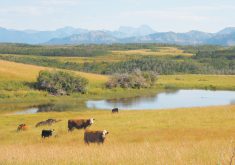Editor’s note: This is the fifth of a series of columns looking at the lessons learned from the financial crisis of 2008.
Basic assumptions failed. Reasonable expectations were vexed. Predicting the future became perilous for any prognosticator.
However, Phil Shaw found an old lesson verified in the aftermath of the financial crisis of 2008-09: interest rates matter.
“For me, who paid for most of my land at 14 percent and higher and who had my first demand loan on the farm for 23.25 percent, it has been a sobering time,” Shaw, an Ontario farmer, market columnist and agricultural economist, said as he looked back over the past decade of financial mayhem and compared it to a previous era.
Read Also

Huge Black Sea flax crop to provide stiff competition
Russia and Kazakhstan harvested huge flax crops and will be providing stiff competition in China and the EU.
His own farming experience of the 1980s showed him how high interest rates can provoke farm failures and stress.
Other stories in this series:
- Remembering the lessons from the 2008 financial crisis
- Hedging makes sense, but manage them
- Knowing your lender when times get rough pays dividends
- Manage farms like low-margin, high-volume businesses
- Farmers can learn lessons from 2008 financial crisis
- Financial crisis of 2008 helped test market theories
He expected to see pressure hitting farming from the flood of money, including the quantitative easing engineered by the U.S. Federal Reserve Bank system in the aftermath of the 2008 crisis, spurring inflation just as crop prices had plunged in the wake of the meltdown.
However, he was surprised by two factors: the resiliency of crop prices, which quickly bounced back, and the failure of inflation and interest rates to rise.
“There were many people that felt that this would eventually cause widespread inflation,” Shaw said about the impact of quantitative easing.
“I must admit my economic training taught me that as well.”
The opposite occurred. Interest rates hit historical bottoms as the real economy limped along. Farm country was doing well again as grain markets recovered, and struggling urban areas across the developed world kept a lid on inflation.
However, this had a massive impact on the farm economy, even if it wasn’t at all like the high interest rate crisis of Shaw’s farming youth. Instead, grain farmers saw massive increases in the value of their farmland as mortgage money became dirt cheap to borrow and profitability returned, spurring farmers and non-farmers to buy farmland.
“This phenomenon … has been like testosterone in the agricultural economy…. It is a big stimulus to agricultural production, and it’s made the acquisition of fixed assets, like land and equipment, very easy,” said Shaw.
“If you have a few tough years on the price front, it is very easy to service debt levels because interest rates are so low.”
I corresponded with Phil about this around the 10-year anniversary of the full-out crisis erupting in mid-September 2008. Since then, interest rates have been rising with central bankers pushing their key rates and with bond yields surging in a combination of inflation anticipation and risk-on credit wariness returning to the markets after years of complacency.
Rates are still far below levels considered “normal” before the crisis, but they are getting back to a normal range.
What will that mean to farmers? I plan to ask Phil and others about that in coming weeks because not only have we already seen two interest rate situations have an outsized effect on farming, but we might be heading into a third one.
The 1980s high interest rate period sparked a farm crisis that most still remember. The 2009-18 low interest rate period has spurred an incredible increase in the value of farmland and the desire of farmers to borrow money to buy it. Farmers have also learned to live with a decade of cheap operating credit.
If the low interest period is ending, how is that going to affect things down on the farm? We can’t see the future, but we can look at the past and see that interest rates aren’t a secondary issue for farmers when they move. They can become the arguably single most important factor in a farm’s long-term viability.
Like Phil, we can’t always correctly anticipate which way they will move and what impact that will have, but we can similarly watch carefully because the impact can be immense.
That’s one of the key lessons the 1980s farm crisis and the 2008-09 financial crisis have taught.

















